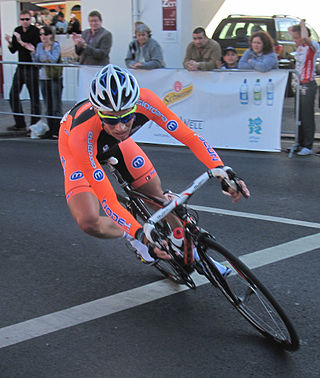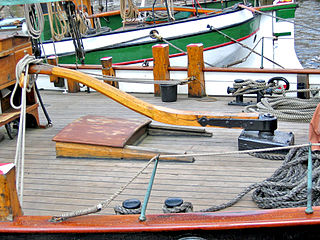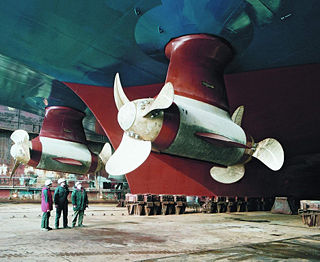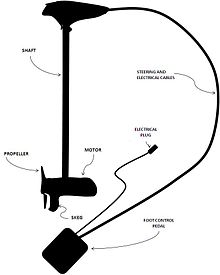
A propeller is a device with a rotating hub and radiating blades that are set at a pitch to form a helical spiral which, when rotated, exerts linear thrust upon a working fluid such as water or air. Propellers are used to pump fluid through a pipe or duct, or to create thrust to propel a boat through water or an aircraft through air. The blades are shaped so that their rotational motion through the fluid causes a pressure difference between the two surfaces of the blade by Bernoulli's principle which exerts force on the fluid. Most marine propellers are screw propellers with helical blades rotating on a propeller shaft with an approximately horizontal axis.

An electric boat is a powered watercraft driven by electric motors, which are powered by either on-board battery packs, solar panels or generators.

An outboard motor is a propulsion system for boats, consisting of a self-contained unit that includes engine, gearbox and propeller or jet drive, designed to be affixed to the outside of the transom. They are the most common motorised method of propelling small watercraft. As well as providing propulsion, outboards provide steering control, as they are designed to pivot over their mountings and thus control the direction of thrust. The skeg also acts as a rudder when the engine is not running. Unlike inboard motors, outboard motors can be easily removed for storage or repairs.

Trolling is a method of fishing where one or more fishing lines, baited with lures or bait fish, are drawn through the water. This may be behind a moving boat, or by slowly winding the line in when fishing from a static position, or even sweeping the line from side-to-side, e.g. when fishing from a jetty. Trolling is used to catch pelagic fish such as salmon, mackerel and kingfish.

A radio-controlled model is a model that is steerable with the use of radio control (RC). All types of model vehicles have had RC systems installed in them, including ground vehicles, boats, planes, helicopters and even submarines and scale railway locomotives.

A runabout is any small motorboat holding between four and eight people, well suited to moving about on the water. Characteristically between 20' and 35' in length, runabouts are used for pleasure activities like boating, fishing, and water skiing, as a ship's tender for larger vessels, or in racing. Some common runabout types are bow rider, center console, cuddy boat and walkaround. The world's largest runabout, Pardon Me, is 48 feet long and owned by the Antique Boat Museum in Clayton, New York.

Steering is the control of the direction of locomotion or the components that enable its control. Steering is achieved through various arrangements, among them ailerons for airplanes, rudders for boats, tilting rotors for helicopters, and many more.

A motorboat, speedboat or powerboat is a boat that is exclusively powered by an engine.

A tiller or till is a lever used to steer a vehicle. The mechanism is primarily used in watercraft, where it is attached to an outboard motor, rudder post or stock to provide leverage in the form of torque for the helmsman to turn the rudder. A tiller may also be used in vehicles outside of water, and was seen in early automobiles.

An azimuth thruster is a configuration of marine propellers placed in pods that can be rotated to any horizontal angle (azimuth), making a rudder redundant. These give ships better maneuverability than a fixed propeller and rudder system.

Drive by wire or DbW technology in the automotive industry is the use of electronic or electro-mechanical systems in place of mechanical linkages that control driving functions. The concept is similar to fly-by-wire in the aviation industry. Drive-by-wire may refer to just the propulsion of the vehicle through electronic throttle control, or it may refer to electronic control over propulsion as well as steering and braking, which separately are known as steer by wire and brake by wire, along with electronic control over other vehicle driving functions.

A sterndrive or inboard/outboard drive (I/O) is a form of marine propulsion which combines inboard power with outboard drive. The engine sits just forward of the transom while the drive unit lies outside the hull.
An electronic speed control (ESC) is an electronic circuit that controls and regulates the speed of an electric motor. It may also provide reversing of the motor and dynamic braking. Miniature electronic speed controls are used in electrically powered radio controlled models. Full-size electric vehicles also have systems to control the speed of their drive motors.

The Mark 24 mine is an air-dropped anti-submarine (ASW) acoustic torpedo developed by the United States during World War II; it was called a mine to conceal its capabilities. The torpedo entered service with the Allies in March 1943; the United States Navy (USN) used it until 1948. Approximately 4,000 were produced. Of the 340 deployed during the war, 204 were fired, sinking 37 and damaging 18 Axis submarines.

A radio-controlled boat is a boat or ship model controlled remotely with radio control equipment.

The Kitchen rudder is the familiar name for "Kitchen's Patent Reversing Rudders", a combination rudder and directional propulsion delivery system for relatively slow speed displacement boats which was invented in the early 20th century by John G. A. Kitchen of Lancashire, England. It turns the rudder into a directional thruster, and allows the engine to maintain constant revolutions and direction of drive shaft rotation while altering thrust by use of a control which directs thrust forward or aft. Only the rudder pivots; the propeller itself is on a fixed shaft and does not.
Self-steering gear is equipment used on sail boats to maintain a chosen course or point of sail without constant human action.

Marine propulsion is the mechanism or system used to generate thrust to move a watercraft through water. While paddles and sails are still used on some smaller boats, most modern ships are propelled by mechanical systems consisting of an electric motor or internal combustion engine driving a propeller, or less frequently, in pump-jets, an impeller. Marine engineering is the discipline concerned with the engineering design process of marine propulsion systems.
Remote control fishing is a fishing technique accomplished by using a remote control boat. The remote control fishing boats are almost exclusively battery operated, since batteries provide several benefits when compared with glow engines: less noise during operation, consume no power during idle time, requires no oxygen, easier to maintain, finer power and speed control, etc.

Car controls are the components in automobiles and other powered road vehicles, such as trucks and buses, used for driving and parking.


















